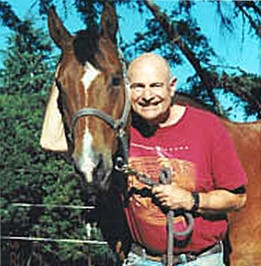A Blessing In Disguise
It's hard to find something pleasant to say about a big, ornery horse that bolts and throws you for no apparent reason, especially when the crash landing results in eye-watering and breath-robbing chest pain. And so thought Dave "Punch" Worthington this summer as he sat hunched over in the Emergency Room of a little hospital south of Salem, Oregon waiting for the results of his chest x-ray.
Punch and his wife Debbie had been caring for Big Arney and Rocky, a pair of horses who were in need of tender loving care and a little exercise in the absence of their Alaska-bound owners, Dr. Joe and Ruth, who is Debbie's sister.
Initially, Punch set out to ride Rocky, but the normally affable horse decided to go on strike like a burro. Punch tried sweet talking Rocky, but Rocky would have none of it. He then considered a swift kick to the horse's ribs, but Punch wasn't wearing his spurs. So Punch elected to switch horses with Debbie and try his luck with Arney.
Normally Docile Horse Bolts
Arney, too, was acting strange that day. As soon as Punch mounted the big guy, the normally unflappable and gentle family-friendly horse decided to bolt. Punch suddenly found himself airborne and landed hard like a sack of cement. Punch was no stranger to a few bumps, bruises or even broken bones. He earned his nickname "Punch" as a boxer in college who compensated for average speed and strength with wolverine-like tenacity. At the age of 65, he enjoyed the thrills and spills of rollerblading along the Willamette River, bow hunting for elk along the Coastal Range and canoeing the John Day River in rugged Eastern Oregon. He had learned to accept the occasional trauma as the price for leading an outdoorsman's life.
So Punch picked himself up off the ground, wiped the blood from his nose, mounted Rocky and rode back to the horse barn which was about a mile. He then dragged himself over to the nearest hospital, knowing on impact that his ribs were broken and that there was nothing a doctor could do about it. Better check it out anyway, he thought.
Broken Ribs and Chest Trauma Prompts Return Visit
The ER doctor came back and as expected reported that Punch had broken 6 or 7 ribs on his left side. The doctor prescribed some pain medication and sent Punch on his way. That night a neighbor, who happened to also be an ER doctor, looked him over and urged Punch to go back to the hospital for a CT scan of his spleen to rule out internal bleeding.
A few days later, on the Fourth of July, again Punch found himself in a hospital waiting for the doctor to saunter in with the results. The good news, this time, was that there was no evidence of damage to the spleen. The "bad" news was the presence of a 2 cm nodule at the edge of his right lung lobe near his heart. The radiologist said it was an irregular mass that was "suspicious for malignancy."
CT Film Reveals Hidden Nodule
Whoa: Punch Worthington didn't like the sound of that. But he knew what to do. Punch had spent the last 11 years working as an asbestos investigator. In that time he had helped and befriended hundreds of asbestos cancer patients. He visited their homes, he visited their job sites, he visited their bedsides and, to his regret, he attended many of their funerals.
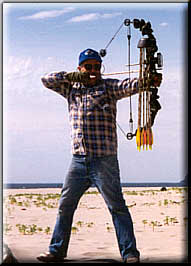
Bow Hunting on the Oregon coast
Fortunately, because of my work in helping to create the Mesothelioma Applied Research Foundation http://www.marf.org, I had a solid relationship with several of the top chest surgeons in the country. We called up Dr. Harvey Pass at Karmanos Cancer Institute in Detroit, Dr. Eric Vallieres at the University of Washington in Seattle, and Dr. Robert Cameron at UCLA. Each of these doctors perform on average about 300 chest operations a year.
Dr. Pass Takes Charge!
Dr. Pass responded to our call immediately, as is his custom. We faxed him the records and a few minutes later we were on the phone. His observations were clean, compelling and thoughtful. Moreover, he was decisive: the kind of general the troops in the field could rally around. "Roger," he said with the frankness I needed to hear, "Your Dad has a new nodule in the middle lobe. The middle lobe can be treacherous surgically because of the potential for spread and unclean margins during surgery. The good news is the neoplasm is isolated, and it doesn't look like the lymph nodes are enlarged [based on his review of the CT report, not film]. This is what we call a 'book 'em' case, meaning we schedule a lobectomy operation in which we perform a wedge resection of the growth and send it down to the lab for a hot read. In the interim, we clean out the growth. If the pathology came back with a non-small cell malignancy, we then clean out the mediastinum, fissures and any other lobes of any potential tumor, dissect surrounding lymph nodes, and remove the entire middle lobe."
More good news. Dr. Pass' view was that this was probably a stage I lung cancer, which he considered curable. If this was indeed the case, there would not be any need for follow up chemotherapy or radiation. Regarding further testing, Dr. Pass discounted the need for invasive pre-surgery testing, such as a needle biopsy, as this would only increase the risk of spread and consume valuable time. As standard pre-operative procedure, Dr. Pass urged but did not mandate pulmonary function and cardiac status testing. He volunteered to call Punch's cardiac doctor and Dr. Gotchall directly to get clearance and he was ready to schedule Punch for hospital admittance and surgery within the week.
Wow! I had heard from my cancer clients that Dr. Pass was a "take charge" doctor, but the swiftness with which he moved from the differential diagnosis to the preferred course of treatment to the actual logistics of the battle plan far exceeded my expectations. His clarity of purpose and sense of mission were reassuring.
Dr. Vallieres All Set to Move Mountains
Next we spoke to Dr. Vallieres in Seattle. We were concerned about the "hot spot" on the right 10th rib, but Dr. Vallieres opined that this was probably related to the rib trauma -- even though Punch landed on his left side, the whole ribcage was violently jarred. Like Dr. Pass, he was not too concerned about the need for pre-surgery testing, as Dr. Gotchall's report (which he described as "excellent") indicated that Punch was otherwise a robust and healthy man. "I could learn most of what I need to know just by talking to him in my office. If he's active, eating well and feeling strong, and not chronically coughing, hiccupping, short of breath or in pain, then he's probably physically ready for an operation."
As a courtesy, Dr. Vallieres also volunteered to call Punch's cardiologist to corroborate his own assessment but would defer any need for pulmonary testing until after he met with the patient.
Dr. Vallieres also agreed with Dr. Pass that the PET scan gave him a strong signal of clear and present danger, and he would err on the side of moving now to operate as opposed to waiting for any more diagnostic testing. On a brighter note, Dr. Vallieres offered that if you're going to lose a lung lobe, the right middle lobe is the one to lose, as it's the smallest of the five lung lobes. He offered to admit Punch on the next Wednesday and operate on him the following day. He warned that the biggest concern after a lobectomy is air leakage, which results in impaired lung function. Finally, intimating that he's seen too many patients who were diagnosed too late, he joked that Punch "ought to send a bag of oats to that horse."
Dr. Cameron Cautiously Optimistic
Next we called Dr. Cameron. I was amazed and grateful that all three doctors were willing to talk to us within a matter of hours. More importantly, each doctor was optimistic that if this indeed was cancer, as it probably was, it could be "nipped in the bud." Dr. Cameron, like Dr. Pass, was a co-founder of MARF. I had the pleasure of witnessing Dr. Cameron in action in the operating room on two of my clients, Hans Hoffacker and Don Thorpe. In both instances, I was impressed with his meticulous care, discipline (not once during the 9 hour procedures did he leave his patient's side), endurance (not once during the operations did he imbibe fluids or secrete same!) and compassion (each time after a full 12 hour day he met with the patient's spouse in the waiting room and carefully explained the procedure and answered all questions).
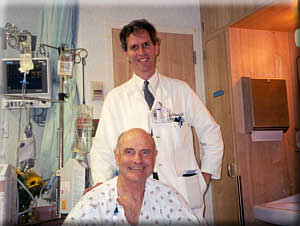
Dr. Robert Cameron and Punch
Dr. Cameron agreed with the other doctors that in all probability we were dealing with a lung primary but he was reluctant to assume this without further inquiry. His main concerns were (1) the metabolic activity on the right 10th rib, which could be a lymphoma, and (2) the risk of lymph node involvement. Although a PET scan may be the best available scanning technique, Dr. Cameron cautioned that it was not fool proof and could not distinguish tumor from inflammation. He would order regular oblique views of the chest to zero in on the nature of that hot spot. Dr. Cameron's approach was both elegant and prudent: "Never treat something unusual as an aberration."
Haste Makes Waste, But Time of Essence
Before he operated, Dr. Cameron had to scientifically rule out metastatic disease. He needed to know that surgery would help and not hinder (which sounded unusual for a surgeon to say, as TV shows like ER have taught us that surgeons tend to cut and ask questions later). For lung cancers, he explained, there was research showing that the timing of chemotherapy and surgery were critical -- if chemotherapy was applied first and surgery followed, there was a much better chance of longer term survival than surgery first and chemotherapy later in the case of metastatic lung cancer.
The demon, Dr. Cameron warned, could be hiding in the lymph nodes. Since CT scans cannot absolutely rule out lymph node involvement, Dr. Cameron spoke of the utility of a mediastinoscopy procedure in which he could biopsy lymph nodes. If there was lymph node involvement, he would favor chemotherapy first and lobectomy surgery second.
Dr. Cameron frowned on the practice of cracking the patient's chest, dissecting a biopsy and waiting for the pathologist's hot read. Although he does them, he cautioned that a frozen section review by a pathologist can be perilous since the pathologist will be rushed and may not have time to perform special stains to rule out artifacts, or to reliably distinguish cancer from non-cancer cells. Haste makes waste.
Ask Questions First, then Cut
Dr. Cameron's method it seemed to me was to work backwards from the worse case scenario. The worst case would be metastatic disease, or a bone-based cancer. The smartest doctor with the sharpest scalpel in the world would be no match for a metastatic or lymphoma type cancer. He knew his limitations, and he wanted us to know them. Dr. Cameron did not tell us what we wanted to hear. He was not a salesman. Nor was he a magician. He would review the films himself with no bias and make his own mind up whether the lymph nodes were normal or the 10th rib hot spot was a broken blood vessel, a cracked bone, an artifact or a neoplasm.
We also spoke to two surgeons in Oregon, both capable, both likeable, both experienced, and both willing to schedule Punch immediately. Punch was now faced with the question: which surgeon do I choose? Do I go with the surgeon who is closest to home? Who is covered by my insurance? Who has published the most articles? Who tells the best jokes? In the end, Punch chose Dr. Cameron and UCLA, primarily because he could prepare for and recover from the surgery in the company of his two sons who lived in Orange County and his brother who lives in Santa Barbara.
Punch and Debbie Fly to Los Angeles
Punch and Debbie packed their bags and flew down to LA. We met with Dr. Cameron on Monday. He showed us the PET scan, CT scan, Bone Scan and chest films. We of course were still holding out for non-malignant "Valley Fever", but the pictures were not encouraging. Dr. Cameron pointed out that the nodule was "spiculated" -- the edges were spiny, which suggested that the tumor was starting to grow what looked like multiple micro-thin spider legs.
This bug had to go. Through it all, Punch on the outside was amazingly calm. Inside, he was still in disbelief and mild shock. But, as is his way, he managed to ease the tension in the air when Dr. Cameron quizzed him about his hunting. "I'm a bow hunter, which means I'm an elk's best friend. Nine years, hundreds of miles, countless hours, several shots fired, but all I've managed to bring home are a bunch of scrapes, cuts, bruises and a few wounded tree branches."
Middle Lobe and Tumor Removed
The next day, August 7th, Dr. Cameron operated on Punch, performing a bronchoscopy, right middle lobe thorascopic wedge resection, radical lymph node dissection and, ultimately, the removal of the right middle lobe. The nodule indeed turned out to be adenocarcinoma. Dr. Cameron examined the fissures between the upper and lower right lobes, and to the naked eye, they appeared to be tumor free.
After the surgery, Punch was wheeled into the ICU, which was buzzing like a big city bus station. Patients on gurneys kept rolling in and out. Others were parked against the walls. Hoses and I.V. bags everywhere. Doctors and nurses scurrying about with clipboards and latex. Punch woke up and managed a feeble smile.
I thought about the time 20 years ago we were packing down a steep cliff on the Oregon Coast when Punch dropped his sunglasses into a deep, crystal clear pool. The water was freezing cold. The sunglasses were cheap, and everybody thought he would just leave them be. "Hey!" he shouted. "I'm an American Indian. We don't litter and there's nothing like an ice bath to bring us closer to the Gods." Before I could say "You're crazy" he stripped naked and dove in. He shot up gasping for air, his eyes bulging, clutching those cheap sunglasses and laughing madly. I touched the water again and confirmed, yes, it was ice cold, and yes, my Dad was "touched in the head."
Road to Recovery Starts in ICU
I gave Punch a left jab like he taught me, careful to keep my right guard up and my chin against my left shoulder, overcome with a mixture of pride and awe. He had just been through a life-altering -- a life saving -- event and yet his spirits were up. He never asked if it was cancer or not and later when I asked him about his stoicism he said he "sort of figured it was so what's the point of dwelling on it? I know it's there, and it may always be with me. It's not fair and it's not right but my goal is to move forward and live each day."
A nurse scooted over with her clipboard and began peppering him with questions in a business as usual fashion. About this time a patient on a gurney next to us started screaming hysterically and wouldn't stop, despite the bland assurances from a flock of nurses which seemed to get bigger and less sympathetic as the wailing escalated. My only thought was to get Punch out of there and up to his hospital room.
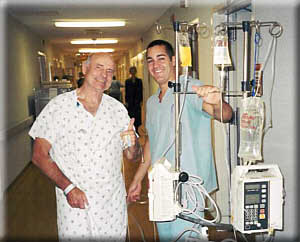
"Road work" at 7 am in the hallways of UCLA Medical Hospital, getting stronger
We finally managed to move upstairs where Punch set out on his road to recovery. Like a prize fighter recovering from a knockout blow, Punch stuck to a strict diet of canned fruit, watery eggs and a hearty suck on the Voldyne 5000 Volumetric Exerciser every 10 minutes. We had hoped he would stay in the hospital only 5 days but complications arose with air leaks. He had a persistent partially collapsed lung that kept him in the hospital until the 12th. Meanwhile the biopsy of the lymph nodes came back clean, which was another good sign that Punch had caught his tumor in its infancy before it began it's deadly march.
Persistent Collapsed Lung Delays Return Home
Punch spent the next few weeks recuperating at our house and his brother Jack's in Santa Barbara. As much as we enjoyed his company, and wanted him to stay, we knew there was no better cure for any illness than the comfort of his own bed. He wanted to fly to Keizer but unfortunately his pneumothorax, which created a lingering and often sharp pain, persisted for another two weeks, which prevented him from returning home on an airplane. He also developed a worrisome cough that I had never heard before. Finally, he decided to travel by train, a trip that would take no less than 26 hours (and which present a whole new host of challenges). He found a way to conceal his drainage tube by wearing baggy Hawaiian shirts and stuffing the reservoir in his front pocket.
On his return, Dr. Gothcall examined Punch and found that the lung had reinflated successfully. A prominent pathologist later reviewed the tumor and tissue removed from the operation and confirmed the presence of mild interstitial fibrosis and asbestos-related lung cancer.
Asbestos Does Not Respect the Color of Your Collar
Punch's cancer diagnosis underscores the lethal nature of asbestos fibers. Regardless of who you are and how long you were exposed, or even when to a degree, the fibers do not respect the color of your collar, your courage, wisdom, good deeds, or even your physical fitness.
Punch had worked around asbestos intermittently since the mid-1950s through 1990, but during those same 40 years he had taken time out to serve his country in the U.S. Marine Corps, graduate from Chico State University (where he also played football and boxed), help raise a family (three boys), earn his Ph.D. in genetics from Oregon State University and teach biology at various junior colleges in California, Washington and Canada. He had left academia in the early 1970s to pursue his passion -- labor union organizing and construction. From the mid 1970's to 1990 he had worked as a painter, drywaller and sandblaster at various sites in the Northwest, including many refineries, paper and pulp mills.
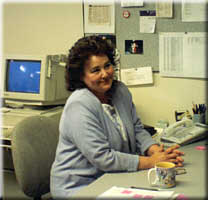
Patti Chandler
" Mixture of Thankfulness and Anger"
Punch looks back on his "Summer of Bummer" with gratitude for everyone who helped him get where he is now:
I couldn't have better people working my corner in this fight. My wife and family and friends along with my medical team at UCLA, as well as those doctors who we consulted and offered their advice freely, were all part of my victory. My initial emotions were a mixture of thankfulness -- to Arney the horse, Dr. Mike Hare (the ER neighbor), Debbie, and to MARF -- but also anger. The anger was a general surging emotion directed at the fact that I had this damn thing in my lung that wouldn't have been there if not for that damn asbestos and everybody who covered up its dangers or looked the other way. I felt fit and thought I lived a fairly clean and healthy life. This uninvited trespasser decided to camp out in my lung and throw a wrench in my plans. On the other hand, I am very lucky and thankful that my tumor was detected early. I am giving Arney carrots and apples every time I go to Ruth and Joe's now. I love that big brown galoot who seemed to sense that something in me was amiss, and just wanted to put me on notice. Thankfullness is now my prevailing emotion.
What kept Punch hopeful and resolute during his recovery, aside from all the usual things? The answer: salmon fishing. Before he flew to LA for his surgery, his good friends Patti Chandler (who used to work as Punch's secretary at the Carpenters Hall) and Tom Laverdure promised Punch a spot on their fishing boat when he returned. "That kept me going -- the dream of getting out there off the Oregon Coast trolling for silvers." A few weeks after his return Punch's dream came true as Tom handed him an extra-special pole, which had been used for years by his best friend Bobby, who died of lung cancer the year before.
Punch recalls:
I had fished with Tom and Bobby a couple of times when Bobby was still able. He was always upbeat and positive despite his metastatic lung cancer and he lived far beyond what the doctors had predicted. Sure enough the first thing in the morning before anyone was catching anything on Bobby's pole I hooked a 30 pound Chinook and after a good fight we landed him. It was a special exuberant feeling and I knew that Bobby would be smiling.
Why is Punch one of the "Lucky Ones?"
Yes, there is much to be thankful for, under the circumstances. Of course none of this would have happened if the asbestos companies and later the jobsite owners and contractors had done the right thing. But I can't help wondering why we were one of the "lucky ones" -- that is, lucky enough to have had a fighting chance, although even now the battle continues, as with any cancer there is always the change of recurrence. But why had Arney, normally so docile, so tame, suddenly bolted? And what is luck? Is it all random, or can we influence our fortunes?
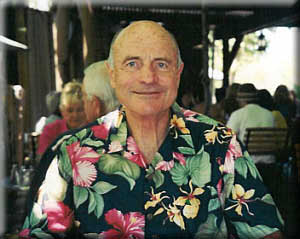
Homeward Bound!
Punch has learned to roll with the punches with a smile as he prepares for 26 hour journey home on Amtrak. San Juan Capistrano, 9/2001
When Punch first told me about Arney and the fall, I thought about a story he had told to his grandson about the time he dropped a big elk. About a year ago, Punch decided his bad aim had spared enough elk and he was actually ready to bring one home. He put down the compound bow, picked up his rifle and headed to "Ten Mile Creek" near Yachats on the Coast. To make a long story short, he spotted a 400-pound bull elk and dropped him with a single shot. As he recaptured the experience for my son, Punch was careful to convey his feelings at the time. He was at once elated, inspired, grateful and also sad for the beautiful animal whose life he had just taken.
Reverence for the Life Force
Before he began the arduous task of gutting the elk and packing it home, he performed a ceremony he had learned from an old Apache Indian. Not having any sage to burn, he instead poured some water from his canteen in his hand and sprinkled the water first to the East (representing the sunrise and source of knowledge), then the South (representing warmth and growth), the West (the origin of power for wind and storms), and then the North (representing wisdom and the change of seasons). He then splashed a little water up to the Cosmos and then down to the Earth, all the while feeling blessed and grateful for the elk and all that sustained him.
What struck me then, and now, was Punch's reverence for other living creatures. The word "animal" comes from the Latin word for "the living", derived in turn from the Latin word for the soul. The Greek philosopher Socrates thought that the gods took the greatest joy from honors received from the people who were most reverent. I can't help thinking that the gods rewarded Punch's reverence for other living creatures through Arney. How fitting it is, that an unexpectedly spirited animal threw Punch and set in motion the chain of events which led to the discovery and removal of the cancer.
Whether it was the gods, fate, or luck, Arney has given Punch more life, but how much remains to be seen. The asbestos fibers which caused the cancer are insidious, and impossible to remove, as are the threats of recurrence and of other asbestos-related cancers. Bloodied but unbowed, "the Sit-Up King" takes on every day, vigilant and full of fighting spirit, breathing in as much life as each day gives.
*** POSTED JANUARY 14, 2002 ***
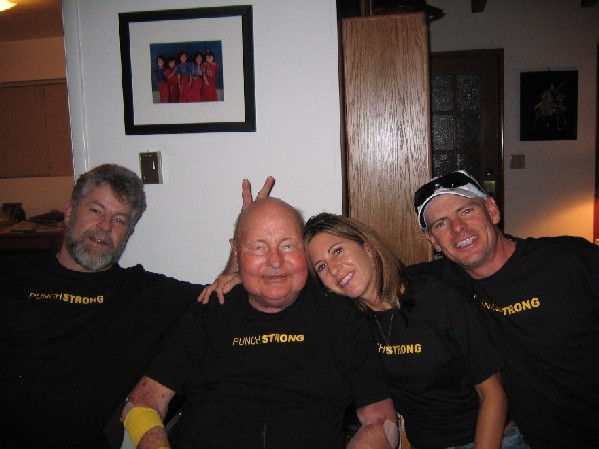
Punchstrong!
Family and friends rally around David "Punch" Worthington, Ph.D, at home in Keizer, Oregon.
August 2, 200
Additional Information:
Punch Out Asbestos Cancer! (8/30/07)
David Hansen "Punch" Worthington, Devoted to Justice (5/14/07)
David Hansen "Punch" Worthington, Ph.D., 1935-2006
Dedication of the Punch Worthington Cancer Research Lab at UCLA Medical School! May 27, 2005
Punch Worthington "Here's why Asbestos Needs All Those Rules", Albany Democrat-Herald (5/29/02)
Punch's Corner Dave "Punch" Worthington, Ph.D, Asbestos Investigator

